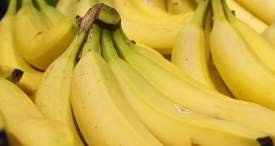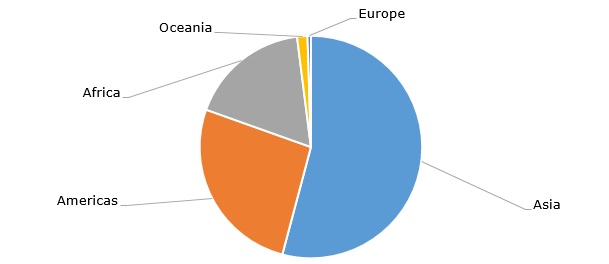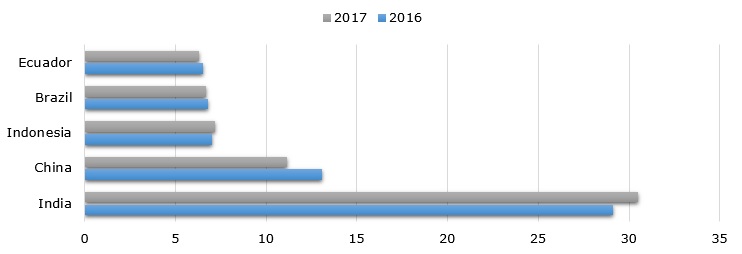India Tops the List of World’s Leading Bananas Producers
30 Jan 2019 • by Natalie Aster

LONDON – Bananas are amid the most produced and consumed fruits from pole to pole. There exist above 1,000 varieties of bananas, however, the most commercialised is the Cavendish type, which commands a share of around 47% of the world’s total bananas output volume. Cavendish banana crops provide high yields and are less prone to damages from different environmental influences (e.g., storms) owing to their short stems, besides, they are also recognised for quick recovery after natural disasters. Moreover, Cavendish bananas are more suitable for international trade than other types of this fruit as they are more resilient to various effects during transportation.
Today, bananas are grown in nearly 135 countries across the subtropics and tropics. Globally, the banana harvested area is estimated at over 5.6 million hectares. The robust upturn of the global banana industry is evident in the expansion of the harvested area over time; thus, in 1993, only 3.6 million hectares were dedicated to banana production worldwide.
The bulk share of banana producers are farmers who grow bananas for home consumption and local market, whilst only 15% of the global production volume of bananas is exported. Therefore, it is impossible to collect precise data on the world’s total banana output. During 2000-2017, the global bananas production demonstrated sustained growth at a modest CAGR of appr. 3.2% and grew from some 67 million tonnes in the year 2000 to a record high of around 114 million tonnes in the year 2017. The increasing consumption requirements of rapidly rising populations (especially in the developing countries) is viewed as the major propeller of the global bananas production growth. The largest contribution to the banana production increase has been made by the top producers who are at the same time top consumers of this fruit (for instance, India, China, Brazil, and the Philippines). Moreover, an enhancing health awareness has considerably propelled the demand for bananas in European and North American countries, which also acted as a growth engine of the global bananas production.
Asia accounts for around half of the world’s total bananas output. In 2017, the region produced over 61.7 million tonnes of bananas. The Americas present the second leading region in terms of bananas production. In 2017, the output volume of bananas in the Americas totaled close to 30 million tonnes, and the region commanded a share of nearly 26% in the global production.
Global bananas production by regions, 2017

Top 5 bananas producers together grab a share of over 54% of the world’s overall bananas output volume. As of 2017, their combined production volume totaled above 61.7 million tonnes. Production in most countries prominent in bananas cultivation majorly serves the needs of the domestic market.
5 leading banana producing countries (in million tonnes)

Here is a comprehensive overview of the world’s top five bananas producing countries:
1. INDIA
India is the number one producer of bananas on the global scale. The country commands a share of about 26% of the world’s total bananas output volume. As of 2017, India produced more than 30.4 million tonnes.
Bananas cultivation is amid the most popular agricultural practices in the country, as this fruit isn’t seasonal in nature and grows the whole year round. Some of the most popular varieties of bananas cultivated in India comprise Nendran, Dwarf Cavendish, Robusta, Poovan, amid others. India’s states with the largest bananas output include Tamil Nadu, West Bengal, Madhya Pradesh, Andhra Pradesh, Maharashtra, Assam, Karnataka, Kerala, Gujarat, and Orissa.
2. CHINA
China stands on the second rank in terms of bananas production volume, accounting for a chunk of nearly 9.8% of the world’s total output. In 2017, the Chinese bananas production totaled slightly over 11 million tonnes. The country’s banana production capacity has dwindled over recent years, however, its output is still pretty impressive and enough to make the country the second leading producer in the world.
In China, bananas are majorly cultivated in 5 provinces: the island of Hainan, Guangxi, Yunnan, Guangdong, and the Fujian. Among these, Hainan offers the best climate for bananas cultivation; south and south-west parts of this island are widely known as the Golden Corridor Area for bananas production.
3. INDONESIA
Indonesia holds the third spot on the list of the global leading bananas with a share of appr. 6.2% of the global output volume. As of 2017, Indonesia produced above 7.1 million tonnes of bananas. Java is the dominant banana producing area in the country, it commands a share of almost 68% of the domestic output. The Cavendish Banana is the major variety produced in and exported from the country, other types cultivated in the country include Pulung, Ngrupit, Porogo, and Bungkal.
4. BRAZIL
Brazil is the fourth biggest producer of bananas across the globe, accounting roughly for 5.8% of the global production volume. As of 2017, Brazil’s bananas production totaled slightly over 6.67 million tonnes.
The state of Sao Paolo commands the biggest chunk of the domestic bananas cultivation, other prominent producing regions comprise Rio de Janeiro and Prata. Brazil is also a prominent bananas exporter especially in South America with Peru, Uruguay, Argentina, and Bolivia being the key export destinations in the region. However, the bulk share of bananas produced in Brazil is consumed domestically.
5. ECUADOR
Ecuador rounds up the top 5 bananas producers in the world, holding a share of nearly 5.5% in the global output volume. In 2017, Ecuador produced slightly more than 6.28 million tonnes of bananas.
Meantime, Ecuador ranks the leading exporter of bananas on the world scale; in 2017, the country’s bananas exports value was worth around USD 3 billion, which is equivalent to some 24% of the world’s total banana exports. Bananas present an important commodity for the Ecuadorian economy as almost half of the country’s production is sold internationally. Bananas production has helped to boost Ecuador’s GDP significantly.
© MarketPublishers.com, 2019
Analytics & News
